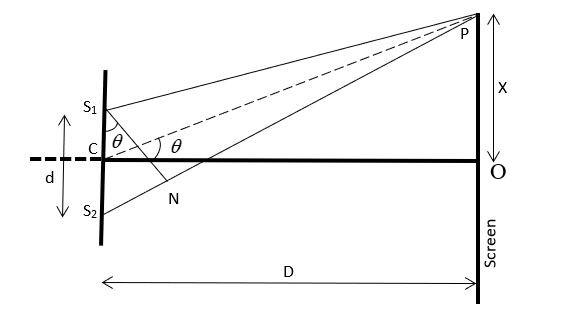
Give analytical treatment of YDSE interference bands and hence obtain the expression for fringe width.
Answer
490.8k+ views
Hint: We will first consider a Young’s double slit experimental setup and then we will find the path difference. After we get the path difference, we will find out the expressions for the distances of bright and dark fringes from the central fringe. Then the fringe width can be calculated by measuring the distance of two consecutive bright and dark fringes and then subtracting them.
Complete step by step solution:
Let us consider a setup of the Young’s double slit experiment.

Here, ${S}_{1}$ and ${S}_{2}$ are the two parallel and closely spaced slits having equal widths and distance d between them. Two monochromatic coherent sources of light having wavelength $\lambda$ emerge through these two slits whose interference patterns can be seen on a screen placed D distance apart from the slits such that D >> d.
CN is the perpendicular bisector of ${S}_{1}{S}_{2}$ that intersects the screen at N.
Now, consider a point P on the screen at distance x from O, where the two light waves reach through paths ${S}_{1}P$ and ${S}_{2}P$ respectively. And ${S}_{1}N$ is a perpendicular on the path ${S}_{2}N$.
Now, from the figure, we can write that,
$({S}_{2}P)^2 =D^2 +(x+\dfrac{d}{2})^2$ ………. (i)
and $({S}_{1}P)^2=D^2 +(x-\dfrac{d}{2})^2$ ………. (ii)
Upon subtracting equation (i) from (ii), we will get
$({S}_{2}P)^2 – ({S}_{1}P)^2=D^2 +(x+\dfrac{d}{2})^2 -D^2 – (x-\dfrac{d}{2})^2$
On solving the equation, we will have
$\implies ({S}_{2}P +{S}_{1}P)({S}_{2}P-{S}_{1}P)=2xd$
$\implies {S}_{2}P-{S}_{1}P=\dfrac{2xd}{{S}_{2}P +{S}_{1}P}$
Practically, D is very much greater than x and d, such that ${S}_{2}P+{S}_{1}P\simeq 2D$
Therefore, path difference $({S}_{2}P-{S}_{1}P)=\dfrac{2xd}{2D}=\dfrac{xd}{D}$ ………. (iii)
The expression for fringe width (say X) can be found by finding the distance between two consecutive bright or dark fringes.
Now, if at point P, there is a bright fringe, then the path difference, $\dfrac{xd}{D}=n\lambda$, having n = 0, 1,2, 3….
And if at point P, there is a dark fringe, then the path difference, $\dfrac{xd}{D}=(2n-1)\dfrac{\lambda}{2}$, having n=1, 2, 3….
Now, let us assume that ${x}_{n}$ and ${x}_{n+1}$, be the distances of $n^{th}$ and $(n+1)^{th}$ bright fringe from the central maximum.
Therefore, ${x}_{n}=\dfrac{n\lambda D}{d}$……….. (iv)
and, ${x}_{n+1}=\dfrac{(n+1)\lambda D}{d}$ ………. (v)
Upon subtracting (v) from (iv), we get
Fringe width, $X=\dfrac{(n+1)\lambda D}{d}-\dfrac{n\lambda D}{d}=\dfrac{\lambda D}{d}(n+1-n) = \dfrac{\lambda D}{d}$
Hence, fringe width is given by $\dfrac{\lambda D}{d}$.
Note: The fringe width can be calculated by finding the distance between two consecutive dark or bright fringes. The distances between the two slits are very small and that is why they have been neglected in the derivation.
Complete step by step solution:
Let us consider a setup of the Young’s double slit experiment.

Here, ${S}_{1}$ and ${S}_{2}$ are the two parallel and closely spaced slits having equal widths and distance d between them. Two monochromatic coherent sources of light having wavelength $\lambda$ emerge through these two slits whose interference patterns can be seen on a screen placed D distance apart from the slits such that D >> d.
CN is the perpendicular bisector of ${S}_{1}{S}_{2}$ that intersects the screen at N.
Now, consider a point P on the screen at distance x from O, where the two light waves reach through paths ${S}_{1}P$ and ${S}_{2}P$ respectively. And ${S}_{1}N$ is a perpendicular on the path ${S}_{2}N$.
Now, from the figure, we can write that,
$({S}_{2}P)^2 =D^2 +(x+\dfrac{d}{2})^2$ ………. (i)
and $({S}_{1}P)^2=D^2 +(x-\dfrac{d}{2})^2$ ………. (ii)
Upon subtracting equation (i) from (ii), we will get
$({S}_{2}P)^2 – ({S}_{1}P)^2=D^2 +(x+\dfrac{d}{2})^2 -D^2 – (x-\dfrac{d}{2})^2$
On solving the equation, we will have
$\implies ({S}_{2}P +{S}_{1}P)({S}_{2}P-{S}_{1}P)=2xd$
$\implies {S}_{2}P-{S}_{1}P=\dfrac{2xd}{{S}_{2}P +{S}_{1}P}$
Practically, D is very much greater than x and d, such that ${S}_{2}P+{S}_{1}P\simeq 2D$
Therefore, path difference $({S}_{2}P-{S}_{1}P)=\dfrac{2xd}{2D}=\dfrac{xd}{D}$ ………. (iii)
The expression for fringe width (say X) can be found by finding the distance between two consecutive bright or dark fringes.
Now, if at point P, there is a bright fringe, then the path difference, $\dfrac{xd}{D}=n\lambda$, having n = 0, 1,2, 3….
And if at point P, there is a dark fringe, then the path difference, $\dfrac{xd}{D}=(2n-1)\dfrac{\lambda}{2}$, having n=1, 2, 3….
Now, let us assume that ${x}_{n}$ and ${x}_{n+1}$, be the distances of $n^{th}$ and $(n+1)^{th}$ bright fringe from the central maximum.
Therefore, ${x}_{n}=\dfrac{n\lambda D}{d}$……….. (iv)
and, ${x}_{n+1}=\dfrac{(n+1)\lambda D}{d}$ ………. (v)
Upon subtracting (v) from (iv), we get
Fringe width, $X=\dfrac{(n+1)\lambda D}{d}-\dfrac{n\lambda D}{d}=\dfrac{\lambda D}{d}(n+1-n) = \dfrac{\lambda D}{d}$
Hence, fringe width is given by $\dfrac{\lambda D}{d}$.
Note: The fringe width can be calculated by finding the distance between two consecutive dark or bright fringes. The distances between the two slits are very small and that is why they have been neglected in the derivation.
Recently Updated Pages
Master Class 11 Accountancy: Engaging Questions & Answers for Success

Express the following as a fraction and simplify a class 7 maths CBSE

The length and width of a rectangle are in ratio of class 7 maths CBSE

The ratio of the income to the expenditure of a family class 7 maths CBSE

How do you write 025 million in scientific notatio class 7 maths CBSE

How do you convert 295 meters per second to kilometers class 7 maths CBSE

Trending doubts
Which are the Top 10 Largest Countries of the World?

What is a transformer Explain the principle construction class 12 physics CBSE

Differentiate between homogeneous and heterogeneous class 12 chemistry CBSE

Draw a labelled sketch of the human eye class 12 physics CBSE

What are the major means of transport Explain each class 12 social science CBSE

What is the Full Form of PVC, PET, HDPE, LDPE, PP and PS ?




